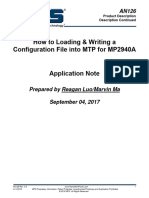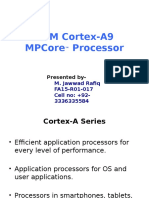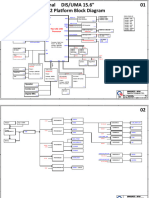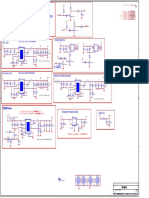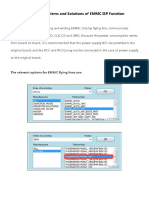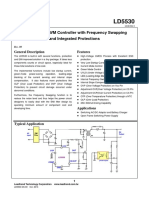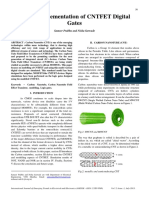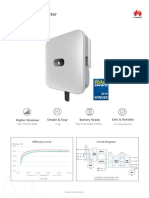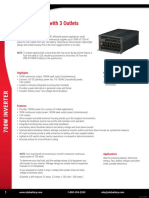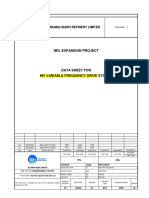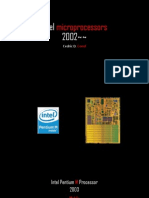Unor3smbus 2.ino
Uploaded by
M. Randy AswinUnor3smbus 2.ino
Uploaded by
M. Randy Aswin/**********************************
* SMBus FOR 3DR SOLO with Arduino UNO R3
* STAVROPOULOS
* Code Version 0.02 beta
*
* MUCH OF THIS CODE WAS COPIED FROM
* https://github.com/PowerCartel/PackProbe/blob/master/PackProbe/PackProbe.ino
*
https://github.com/ArduPilot/PX4Firmware/blob/master/src/drivers/batt_smbus/batt_sm
bus.cpp
*
**********************************/
/**********************************
* Configured for Arduino UNO R3
* you will need to use external pull up resistors of
* 4.7k-ohm to pull the SDA and SCL lines up to 3.3v
**********************************/
/**********************************
* CONFIGURE I2C/SERIAL ON ARDUINO
**********************************/
//DEFINE SDA AND SCL PINS
#define SCL_PIN 5 //COMMUNICATION PIN 5 ON MEGA
#define SCL_PORT PORTC
#define SDA_PIN 4 //COMMUNICATION PIN 6 ON MEGA
#define SDA_PORT PORTC
//CONFIGURE I2C MODES
#define I2C_TIMEOUT 100 //PREVENT SLAVE DEVICES FROM STRETCHING LOW
PERIOD OF THE CLOCK INDEFINITELY AND LOCKING UP MCU BY DEFINING TIMEOUT
//#define I2C_NOINTERRUPT 1 //SET TO 1 IF SMBus DEVICE CAN TIMEOUT
//#define I2C_FASTMODE 1 //THE STANDARD I2C FREQ IS 100kHz. USE THIS TO
PERMIT FASTER UP TO 400kHz.
//#define I2C_SLOWMODE 1 //THE STANDARD I2C FREQ IS 100kHz. USE THIS
TO PERMIT SLOWER, DOWN TO 25kHz.
#define BAUD_RATE 115200
#include <SoftI2CMaster.h>
/**********************************
* CONFIGURE SERIAL LIBRARY
**********************************/
//#include <SoftwareSerial.h>
//#include <Serial.h>
#include <Wire.h>
/**********************************
* DEFINE VARIABLES AND SMBus MAPPINGS
**********************************/
#define BATT_SMBUS_ADDR 0x0B ///< I2C address
#define BATT_SMBUS_ADDR_MIN 0x08 ///< lowest
possible address
#define BATT_SMBUS_ADDR_MAX 0x7F ///< highest
possible address
//BUS MAPPINGS FROM DEV.3DR
#define BATT_SMBUS_TEMP 0x08 ///< temperature
register
#define BATT_SMBUS_VOLTAGE 0x09 ///< voltage
register
#define BATT_SMBUS_REMAINING_CAPACITY 0x0f ///< predicted
remaining battery capacity as a percentage
#define BATT_SMBUS_FULL_CHARGE_CAPACITY 0x10 ///< capacity
when fully charged
#define BATT_SMBUS_DESIGN_CAPACITY 0x18 ///< design
capacity register
#define BATT_SMBUS_DESIGN_VOLTAGE 0x19 ///< design
voltage register
#define BATT_SMBUS_SERIALNUM 0x1c ///< serial
number register
#define BATT_SMBUS_MANUFACTURE_NAME 0x20 ///< manufacturer
name
#define BATT_SMBUS_MANUFACTURE_DATA 0x23 ///< manufacturer
data
#define BATT_SMBUS_MANUFACTURE_INFO 0x25 ///< cell voltage
register
#define BATT_SMBUS_CURRENT 0x2a ///< current
register
#define BATT_SMBUS_MEASUREMENT_INTERVAL_US (1000000 / 10) ///< time in
microseconds, measure at 10hz
#define BATT_SMBUS_TIMEOUT_US 10000000 ///< timeout
looking for battery 10seconds after startup
#define BATT_SMBUS_BUTTON_DEBOUNCE_MS 300 ///< button holds
longer than this time will cause a power off event
#define BATT_SMBUS_PEC_POLYNOMIAL 0x07 ///< Polynomial
for calculating PEC
#define BATT_SMBUS_I2C_BUS PX4_I2C_BUS_EXPANSION
//BUS MAPPINGS FROM SMBus PROTOCOL DOCUMENTATION
#define BATTERY_MODE 0x03
#define CURRENT 0x0A
#define RELATIVE_SOC 0x0D
#define ABSOLUTE_SOC 0x0E
#define TIME_TO_FULL 0x13
#define CHARGING_CURRENT 0x14
#define CHARGING_VOLTAGE 0x15
#define BATTERY_STATUS 0x16
#define CYCLE_COUNT 0x17
#define SPEC_INFO 0x1A
#define MFG_DATE 0x1B
#define DEV_NAME 0x21 // String
#define CELL_CHEM 0x22 // String
#define CELL4_VOLTAGE 0x3C // Indidual cell voltages don't work on
Lenovo and Dell Packs
#define CELL3_VOLTAGE 0x3D
#define CELL2_VOLTAGE 0x3E
#define CELL1_VOLTAGE 0x3F
#define STATE_OF_HEALTH 0x4F
//END BUS MAPPINGS
#define bufferLen 32
uint8_t i2cBuffer[bufferLen];
// standard I2C address for Smart Battery packs
byte deviceAddress = BATT_SMBUS_ADDR;
void setup()
{
//INITIATE SERIAL CONSOLE
Serial.begin(BAUD_RATE);
Serial.println(i2c_init());
//SETUP I2C INPUT PINS
//pinMode(27,INPUT_PULLUP); //use external pull up
resistor instead
//pinMode(28,INPUT_PULLUP); //use external pull up
resistor instead
Serial.flush();
while (!Serial) {
; //wait for Console port
to connect.
}
Serial.println("Console Initialized");
i2c_init(); //i2c_start initialized
the I2C system. will return false if bus is locked.
Serial.println("I2C Inialized");
scan();
}
int fetchWord(byte func)
{
i2c_start(deviceAddress<<1 | I2C_WRITE); //Initiates a transfer
to the slave device with the (8-bit) I2C address addr.
//Alternatively, use
i2c_start_wait which tries repeatedly to start transfer until acknowledgment
received
//i2c_start_wait(deviceAddress<<1 | I2C_WRITE);
i2c_write(func); //Sends a byte to the
previously addressed device. Returns true if the device replies with an ACK.
i2c_rep_start(deviceAddress<<1 | I2C_READ); //Sends a repeated
start condition, i.e., it starts a new transfer without sending first a stop
condition.
byte b1 = i2c_read(false); //i2c_read Requests to
receive a byte from the slave device. If last is true,
//then a NAK is sent
after receiving the byte finishing the read transfer sequence.
byte b2 = i2c_read(true);
i2c_stop(); //Sends a stop
condition and thereby releases the bus.
return (int)b1|((( int)b2)<<8);
}
uint8_t i2c_smbus_read_block ( uint8_t command, uint8_t* blockBuffer, uint8_t
blockBufferLen )
{
uint8_t x, num_bytes;
i2c_start((deviceAddress<<1) + I2C_WRITE);
i2c_write(command);
i2c_rep_start((deviceAddress<<1) + I2C_READ);
num_bytes = i2c_read(false); //num of bytes; 1
byte will be index 0
num_bytes = constrain(num_bytes,0,blockBufferLen-2); //room for null at
the end
for (x=0; x<num_bytes-1; x++) { //-1 because
x=num_bytes-1 if x<y; last byte needs to be "nack"'d, x<y-1
blockBuffer[x] = i2c_read(false);
}
blockBuffer[x++] = i2c_read(true); //this will nack the
last byte and store it in x's num_bytes-1 address.
blockBuffer[x] = 0; // and null it at
last_byte+1
i2c_stop();
return num_bytes;
}
void scan()
{
byte i = 0;
for ( i= 0; i < 127; i++ )
{
Serial.print("Address: 0x");
Serial.print(i,HEX);
bool ack = i2c_start(i<<1 | I2C_WRITE);
if ( ack ) {
Serial.println(": OK");
Serial.flush();
}
else {
Serial.println(": -");
Serial.flush();
}
i2c_stop();
}
}
void loop()
{
uint8_t length_read = 0;
Serial.print("Manufacturer Name: ");
length_read = i2c_smbus_read_block(BATT_SMBUS_MANUFACTURE_NAME, i2cBuffer,
bufferLen);
Serial.write(i2cBuffer, length_read);
Serial.println("");
Serial.print("Manufacturer Data: ");
length_read = i2c_smbus_read_block(BATT_SMBUS_MANUFACTURE_DATA, i2cBuffer,
bufferLen);
Serial.write(i2cBuffer, length_read);
Serial.println("");
Serial.print("Manufacturer Info: ");
length_read = i2c_smbus_read_block(BATT_SMBUS_MANUFACTURE_INFO, i2cBuffer,
bufferLen);
Serial.write(i2cBuffer, length_read);
Serial.println("");
Serial.print("Design Capacity: " );
Serial.println(fetchWord(BATT_SMBUS_DESIGN_CAPACITY));
Serial.print("Design Voltage: " );
Serial.println(fetchWord(BATT_SMBUS_DESIGN_VOLTAGE));
Serial.print("Serial Number: ");
Serial.println(fetchWord(BATT_SMBUS_SERIALNUM));
Serial.print("Voltage: ");
Serial.println((float)fetchWord(BATT_SMBUS_VOLTAGE)/1000);
Serial.print("Full Charge Capacity: " );
Serial.println(fetchWord(BATT_SMBUS_FULL_CHARGE_CAPACITY));
Serial.print("Remaining Capacity: " );
Serial.println(fetchWord(BATT_SMBUS_REMAINING_CAPACITY));
Serial.print("Temp: ");
unsigned int tempk = fetchWord(BATT_SMBUS_TEMP);
Serial.println((float)tempk/10.0-273.15);
Serial.print("Current (mA): " );
Serial.println(fetchWord(BATT_SMBUS_CURRENT));
Serial.print("Device Name: ");
length_read = i2c_smbus_read_block(DEV_NAME, i2cBuffer, bufferLen);
Serial.write(i2cBuffer, length_read);
Serial.println("");
Serial.print("Chemistry ");
length_read = i2c_smbus_read_block(CELL_CHEM, i2cBuffer, bufferLen);
Serial.write(i2cBuffer, length_read);
Serial.println("");
String formatted_date = "Manufacture Date (Y-M-D): ";
int mdate = fetchWord(MFG_DATE);
int mday = B00011111 & mdate;
int mmonth = mdate>>5 & B00001111;
int myear = 1980 + (mdate>>9 & B01111111);
formatted_date += myear;
formatted_date += "-";
formatted_date += mmonth;
formatted_date += "-";
formatted_date += mday;
Serial.println(formatted_date);
Serial.print("Specification Info: ");
Serial.println(fetchWord(SPEC_INFO));
Serial.print("Cycle Count: " );
Serial.println(fetchWord(CYCLE_COUNT));
Serial.print("Relative Charge(%): ");
Serial.println(fetchWord(RELATIVE_SOC));
Serial.print("Absolute Charge(%): ");
Serial.println(fetchWord(ABSOLUTE_SOC));
Serial.print("Minutes remaining for full charge: ");
Serial.println(fetchWord(TIME_TO_FULL));
// These aren't part of the standard, but work with some packs.
// They don't work with the Lenovo and Dell packs we've tested
Serial.print("Cell 1 Voltage: ");
Serial.println(fetchWord(CELL1_VOLTAGE));
Serial.print("Cell 2 Voltage: ");
Serial.println(fetchWord(CELL2_VOLTAGE));
Serial.print("Cell 3 Voltage: ");
Serial.println(fetchWord(CELL3_VOLTAGE));
Serial.print("Cell 4 Voltage: ");
Serial.println(fetchWord(CELL4_VOLTAGE));
Serial.print("State of Health: ");
Serial.println(fetchWord(STATE_OF_HEALTH));
Serial.print("Battery Mode (BIN): 0b");
Serial.println(fetchWord(BATTERY_MODE),BIN);
Serial.print("Battery Status (BIN): 0b");
Serial.println(fetchWord(BATTERY_STATUS),BIN);
Serial.print("Charging Current: ");
Serial.println(fetchWord(CHARGING_CURRENT));
Serial.print("Charging Voltage: ");
Serial.println(fetchWord(CHARGING_VOLTAGE));
Serial.print("Current (mA): " );
Serial.println(fetchWord(CURRENT));
Serial.println(".");
delay(5000);
}
You might also like
- AN126 - r3.0 - MP2940A Programming GuideNo ratings yetAN126 - r3.0 - MP2940A Programming Guide13 pages
- Arm Cortex-A9 Mpcore Processor: Presented byNo ratings yetArm Cortex-A9 Mpcore Processor: Presented by25 pages
- Philips - Gravador DVD DVDR615 - Manual de Serviço - 14123101 PDFNo ratings yetPhilips - Gravador DVD DVDR615 - Manual de Serviço - 14123101 PDF126 pages
- Computer Organization Hamacher Instructor Manual Solution - Chapter 767% (3)Computer Organization Hamacher Instructor Manual Solution - Chapter 713 pages
- The Drive Design of The STM32-based Brushless DC Motor: Song Wang, Wang Guo, Wenqiang DunNo ratings yetThe Drive Design of The STM32-based Brushless DC Motor: Song Wang, Wang Guo, Wenqiang Dun9 pages
- Casper Nl8k Danl8kmbaf0 Rev-F SchematicNo ratings yetCasper Nl8k Danl8kmbaf0 Rev-F Schematic66 pages
- Open Programmer, An Open Source USB Programmer For PIC, ATMEL AVR, I2C-SPI-MicroWire-OneWire-UNIO EEPROM100% (1)Open Programmer, An Open Source USB Programmer For PIC, ATMEL AVR, I2C-SPI-MicroWire-OneWire-UNIO EEPROM31 pages
- Sualaptop365.edu - VN - HP ProBook 430 G3 DA0X61MB6G0 Quanta X61 DIS - UMA R1a 0417 PDF50% (2)Sualaptop365.edu - VN - HP ProBook 430 G3 DA0X61MB6G0 Quanta X61 DIS - UMA R1a 0417 PDF65 pages
- R23 Amd Sabin Uma/Muxless System Diagram: AMD AMD Llano APUNo ratings yetR23 Amd Sabin Uma/Muxless System Diagram: AMD AMD Llano APU40 pages
- Floris Yebisu Nb8511 Nb8512 Ub v4 FinalNo ratings yetFloris Yebisu Nb8511 Nb8512 Ub v4 Final10 pages
- Golam Mostafa: Atmega8 Risc Microcontroller Interfacing and System DesignNo ratings yetGolam Mostafa: Atmega8 Risc Microcontroller Interfacing and System Design60 pages
- 05/23 Change To Voltage Control FAN: LPC & MiscNo ratings yet05/23 Change To Voltage Control FAN: LPC & Misc1 page
- WWW Mikroe Com Chapters View 69 Chapter 6 Examples100% (1)WWW Mikroe Com Chapters View 69 Chapter 6 Examples67 pages
- Acer Swift 1 SF113-31 Pegatron AS3EA UMA Armani r2.0 SchematicNo ratings yetAcer Swift 1 SF113-31 Pegatron AS3EA UMA Armani r2.0 Schematic93 pages
- Acer Aspire 3680 (Quanta ZR1) SchematicsNo ratings yetAcer Aspire 3680 (Quanta ZR1) Schematics30 pages
- Acer - Aspire 740g Platforma Wistron Jv70-Cp Rev - 1No ratings yetAcer - Aspire 740g Platforma Wistron Jv70-Cp Rev - 167 pages
- Green-Mode PWM Controller With Frequency Swapping and Integrated ProtectionsNo ratings yetGreen-Mode PWM Controller With Frequency Swapping and Integrated Protections16 pages
- #Include #Include #Include #Include #IncludeNo ratings yet#Include #Include #Include #Include #Include4 pages
- How To Write An Industry-Standard EEPROM (24C04) Using The MAX2990 I C InterfaceNo ratings yetHow To Write An Industry-Standard EEPROM (24C04) Using The MAX2990 I C Interface4 pages
- Interfacing I2C Serial Real-Time Clocks To A MicrocontrollerNo ratings yetInterfacing I2C Serial Real-Time Clocks To A Microcontroller11 pages
- دوك imu تءارق للاخ نم هنم دكاتلاو ليدعتلا لازم يبي لدعم scoopNo ratings yetدوك imu تءارق للاخ نم هنم دكاتلاو ليدعتلا لازم يبي لدعم scoop33 pages
- Interfacing I2C Serial Real-Time Clocks To A MicrocontrollerNo ratings yetInterfacing I2C Serial Real-Time Clocks To A Microcontroller12 pages
- Hspice Implementation of CNTFET Digital GatesNo ratings yetHspice Implementation of CNTFET Digital Gates4 pages
- Solution Manual For Fundamentals of Digital Signal Processing Using MATLAB 2nd Edition by Schilling PDF100% (1)Solution Manual For Fundamentals of Digital Signal Processing Using MATLAB 2nd Edition by Schilling PDF56 pages
- HT32F1755/HT32F1765/HT32F2755 Datasheet: Holtek 32-Bit Microcontroller With ARM Cortex™-M3 CoreNo ratings yetHT32F1755/HT32F1765/HT32F2755 Datasheet: Holtek 32-Bit Microcontroller With ARM Cortex™-M3 Core45 pages
- 700 Watt Inverter With 3 Outlets: DescriptionNo ratings yet700 Watt Inverter With 3 Outlets: Description2 pages
- Collins 30L-1 Manual 7th Edition February 1965No ratings yetCollins 30L-1 Manual 7th Edition February 196530 pages
- Final Date Sheet for all UG Courses (except 2nd Semester)-May 2025 ExaminationsNo ratings yetFinal Date Sheet for all UG Courses (except 2nd Semester)-May 2025 Examinations15 pages
